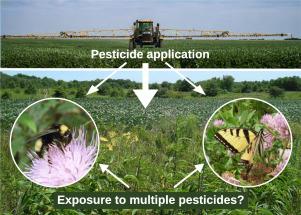Science of the Total Environment ( IF 8.2 ) Pub Date : 2020-06-23 , DOI: 10.1016/j.scitotenv.2020.140436 Anson R Main 1 , Michelle L Hladik 2 , Elisabeth B Webb 3 , Keith W Goyne 1 , Doreen Mengel 4

|
Pesticide exposure is a growing global concern for pollinator conservation. While most current pesticide studies have specifically focused on the impacts of neonicotinoid insecticides toward honeybees and some native bee species, wild pollinators may be exposed to a broader range of agrochemicals. In 2016 and 2017 we collected a total of 637 wild bees and butterflies from the margins of cultivated agricultural fields situated on five Conservation Areas in mid-northern Missouri. Pollinators were composited by individual genera (90 samples) and whole tissues were then analyzed for the presence of 168 pesticides and degradation products. At least one pesticide was detected (% frequency) in the following wild bee genera: Bombus (96%), Eucera (75%), Melissodes (73%), Ptilothrix (50%), Xylocopa (50%), and Megachile (17%). Similarly, at least one pesticide was detected in the following lepidopteran genera: Hemaris (100%), Hylephila (75%), Danaus (60%), and Colias (50%). Active ingredients detected in >2% of overall pollinator samples were as follows: metolachlor (24%), tebuconazole (22%), atrazine (18%), imidacloprid desnitro (13%), bifenthrin (9%), flumetralin (9%), p, p′-DDD (6%), tebupirimfos (4%), fludioxonil (4%), flutriafol (3%), cyproconazole (2%), and oxadiazon (2%). Concentrations of individual pesticides ranged from 2 to 174 ng/g. Results of this pilot field study indicate that wild pollinators are exposed to and are potentially bioaccumulating a wide variety of pesticides in addition to neonicotinoids. Here, we provide evidence that wild bee and butterfly genera may face exposure to a wide range of insecticides, fungicides, and herbicides despite being collected from areas managed for conservation. Therefore, even with the presence of extensive habitat, minimal agricultural activity on Conservation Areas may expose pollinators to a range of pesticides.
中文翻译:

除新烟碱类药物外-野生传粉媒介在农业生态系统中觅食时还接触多种农药。
农药暴露是全球对传粉媒介保护日益关注的问题。尽管当前大多数农药研究都特别关注新烟碱类杀虫剂对蜜蜂和某些本地蜂种的影响,但野生传粉媒介可能会接触到范围更广的农药。在2016年和2017年,我们从密苏里州中北部五个保护区的耕地边缘收集了637只野生蜜蜂和蝴蝶。传粉媒介由单个属(90个样品)合成,然后分析整个组织中是否存在168种农药和降解产物。在以下野生蜂属中至少检测到一种农药(发生率%):熊蜂(96%),欧洲平均水平(75%),蜜蜂花(73%),Ptilothrix(50%),Xylocopa(50%)和Megachile(17%)。同样,在以下鳞翅目属中检测到至少一种农药:Hemaris(100%),Hylephila(75%),Danaus(60%)和Colias(50%)。在总授粉媒介样品中,> 2%的检测到的活性成分如下:甲草胺(24%),戊唑醇(22%),阿特拉津(18%),吡虫啉去硝基(13%),联苯菊酯(9%),氟草定(9%) ),p,p'-DDD(6%),tebupirimfos(4%),氟地西尼(4%),氟曲afol(3%),环丙康唑(2%)和草二唑(2%)。单个农药的浓度范围为2至174 ng / g。这项试验研究的结果表明,除了新烟碱类药物外,野生传粉媒介还暴露于多种农药,并且可能在生物体内积累。在这里,我们提供的证据表明,尽管从保护区采集的野生蜜蜂和蝴蝶属仍可能面临多种杀虫剂,杀真菌剂和除草剂的暴露。因此,即使有广泛的栖息地,











































 京公网安备 11010802027423号
京公网安备 11010802027423号